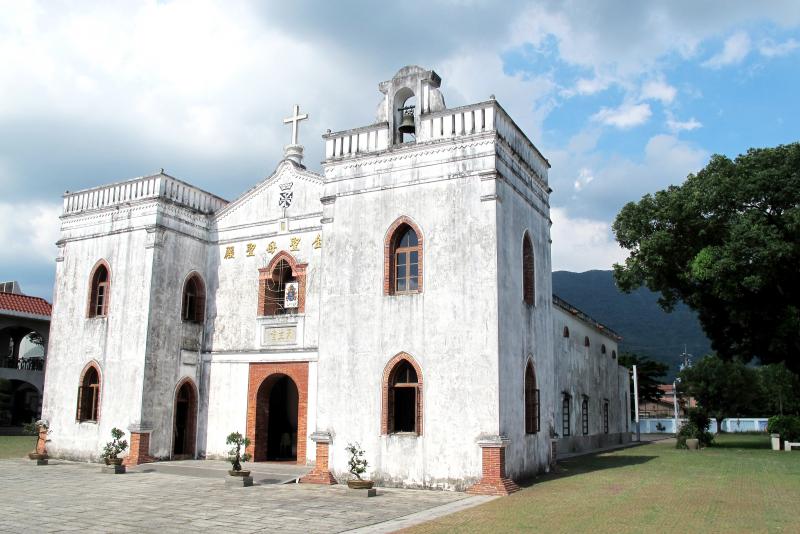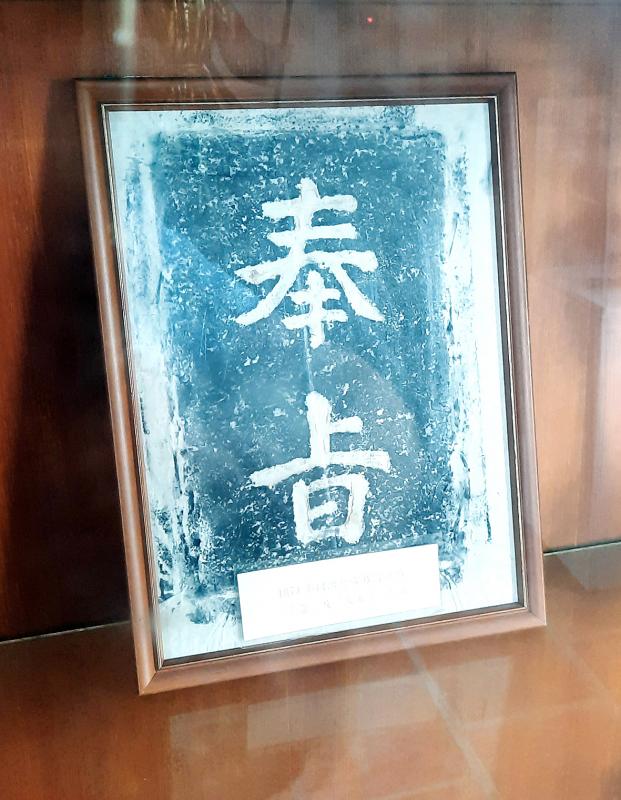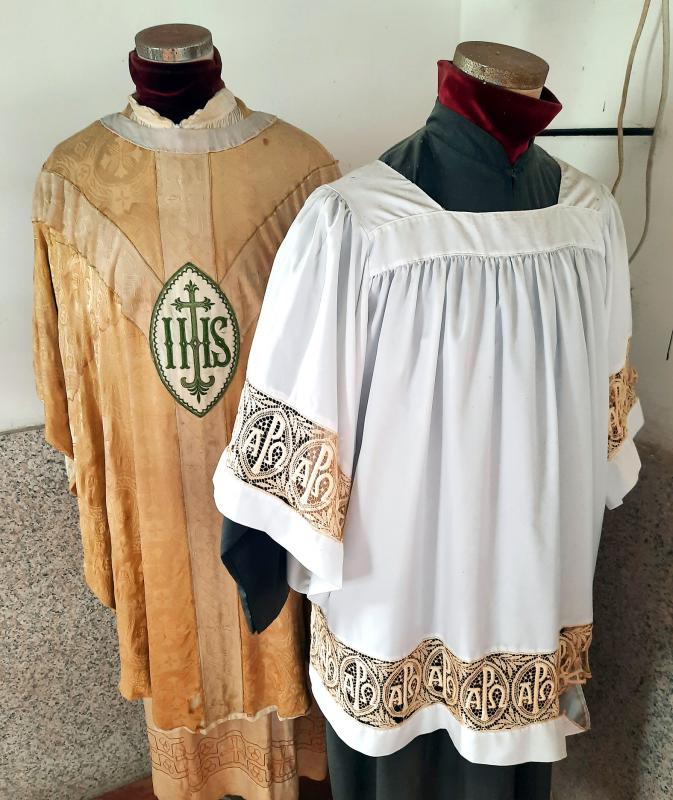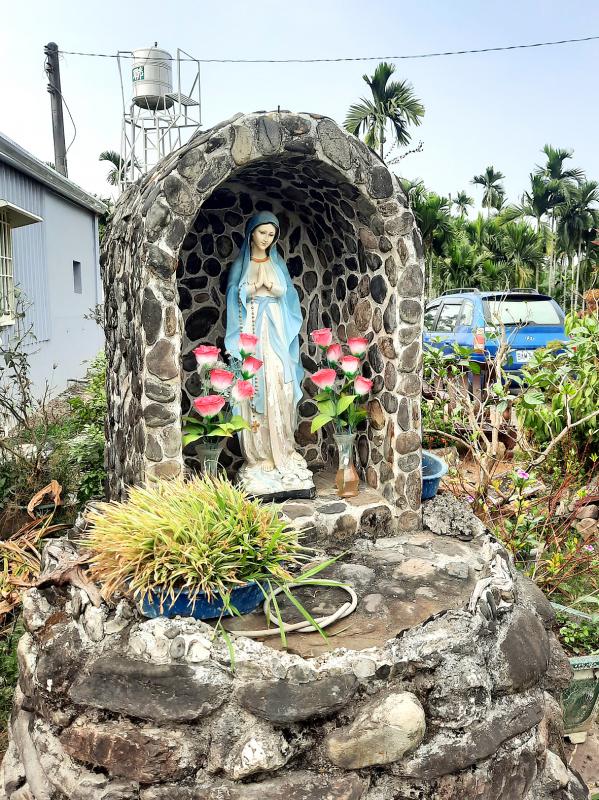Taiwan’s oldest surviving Christian house of worship stands in a village at the base of the Central Mountain Range. Upgraded to a basilica minore by Pope John Paul II in 1984, Wanjin Basilica (萬金聖母聖殿) was established in what’s now Pingtung County’s Wanluan Township (萬巒) in 1863.
The church’s founder, Dominican priest Father Fernando Sainz (郭德剛), was one of the first missionaries to enter Taiwan after the signing in mid-1858 of treaties between Qing China (which ruled the island between 1684 and 1895), France, Great Britain, Russia and the US.
These agreements, collectively known as the Treaty of Tianjin (天津條約), compelled the Qing Dynasty to lift all restrictions on the practice of Catholic, Protestant and Orthodox Christianity. However, it seems this clause wasn’t clearly communicated to every level of the Qing bureaucracy. After Sainz, his fellow Dominican preacher Father Angel Bofurull and four Chinese converts arrived at Takow (today’s Kaohsiung) from the Philippines on May 15, 1859, they were detained by the local magistrate for two days.

Photo: Steven Crook
Once they were freed, things didn’t get much easier. Before the end of the year, illness forced Bofurull to quit the mission, and it’s not clear if the Chinese converts stayed on. At one point Sainz was alone, homeless and having to sleep on a beach.
The Spaniard persisted, and with the help of Matthew Rooney — a Takow-based Irish-American who traded in camphor and opium — he eventually found a place to stay.
Sainz established a church in 1861 in what’s now downtown Kaohsiung. That chapel is long gone, and it’s for his church-planting efforts in the interior that the priest is best remembered.

Photo: Steven Crook
Ordered to search for descendants of Aboriginal people who’d become Christians in the 17th century, when the Protestant Dutch dominated south Taiwan, Sainz ventured across the lowlands where Han settlers were continuing to push the indigenous inhabitants into hillier territory.
Just over 30km due east of his first church, he found a Makatao (馬卡道) community that proved receptive to his message. The Makatao of Wanjin saw Sainz not only as a religious instructor, but also as an outsider whose connection to the Western powers then penetrating East Asia could protect them from the Han majority.
Whether Sainz’s presence helped the Makatao, or actually attracted greater aggression, is moot. The Roman Catholic outpost in Wanjin was the target of repeated attacks by Hakka militia and Paiwan Aboriginal warriors. Sainz himself was kidnapped by Hakka settlers in late 1867, and only released after a ransom of 50 silver dollars was paid. (This was a substantial amount of money; buying the largish plot on which the church stands had cost the priest 62 silver dollars.)

Photo: Steven Crook
The first building, made of adobe and wood, was flattened by an earthquake. Father Francisco Herce (良方濟), who took over as Wanjin’s full-time priest in 1869, oversaw the construction of a larger and more durable “Spanish fortress-style” edifice. If you’ve been to the Philippines, this type of architecture will look familiar.
The basilica is 35m long, 13.7m wide and 7.6m tall. The walls, which in places are 1.3m thick, are made of bricks and stones cemented with a blend of gravel, lime, brown sugar, honey and kapok fiber. Much of the skilled construction work was done by masons and carpenters brought in from Fujian Province, China. Local churchgoers contributed unpaid labor.
The belfry was originally in the center. After it fell down in the 1940s, it was rebuilt on the southern side of the building (on the right as you face the front of the church). The bell was cast in Spain.

Photo: Steven Crook
The church continues to play a central role in the life of the village. It’s said that four fifths of Wanjin’s 2,000-plus people are Catholic — a remarkable proportion, given that Catholics are barely one percent of Taiwan’s population. Marian shrines can be found throughout the village.
Every year, on both the Feast of the Immaculate Conception (December 8) and on Christmas Day, thousands of Catholics from other parts of the country converge on Wanjin Basilica.
At other times, the church draws a steady stream of secular tourists. Those who know what to look for scan the facade for an A4-sized slab of granite near the roof, directly below the cross.

Photo: Steven Crook
Inscribed with the Chinese characters fengzhi (奉旨, “decreed by the highest authorities”), this stone was issued to the church in 1874 on the orders of Emperor Tongzhi (同治), to show that the mission enjoyed imperial protection. It may have had some effect, as the overt hostility previously shown by neighboring settlements quickly subsided.
The church is very visitor-friendly in the sense its doors and grounds are open to the public all day and every day. However, of the items preserved inside display cabinets, none are labeled in English, and very little Chinese-language information is provided. For Taiwanese who grew up unexposed to Catholicism, these exhibits will likely mean nothing.
In addition to priests’ vestments, there is a chalice, a thurible (a small censer suspended by chains), an oil stock (a vessel for holy anointing oil) and a charcoal rubbing of the 1874 edict.
Non-religious mementos include: an Aboriginal headdress decorated with feathers and white lilies; a blow pipe and darts; a hunting rifle; two old cameras; a pair of spectacles; a pair of binoculars; a saxophone; and antique timepieces.
The interior of the basilica is, by Catholic standards, quite plain. Yet there’s definitely something beguiling about Wanjin, its church, the mission’s history and the mountains which — if you’re blessed with good weather — form a gorgeous backdrop.
Steven Crook has been writing about travel, culture and business in Taiwan since 1996. He is the author of Taiwan: The Bradt Travel Guide and co-author of A Culinary History of Taipei: Beyond Pork and Ponlai.

Many people noticed the flood of pro-China propaganda across a number of venues in recent weeks that looks like a coordinated assault on US Taiwan policy. It does look like an effort intended to influence the US before the meeting between US President Donald Trump and Chinese dictator Xi Jinping (習近平) over the weekend. Jennifer Kavanagh’s piece in the New York Times in September appears to be the opening strike of the current campaign. She followed up last week in the Lowy Interpreter, blaming the US for causing the PRC to escalate in the Philippines and Taiwan, saying that as

Taiwan can often feel woefully behind on global trends, from fashion to food, and influences can sometimes feel like the last on the metaphorical bandwagon. In the West, suddenly every burger is being smashed and honey has become “hot” and we’re all drinking orange wine. But it took a good while for a smash burger in Taipei to come across my radar. For the uninitiated, a smash burger is, well, a normal burger patty but smashed flat. Originally, I didn’t understand. Surely the best part of a burger is the thick patty with all the juiciness of the beef, the

This year’s Miss Universe in Thailand has been marred by ugly drama, with allegations of an insult to a beauty queen’s intellect, a walkout by pageant contestants and a tearful tantrum by the host. More than 120 women from across the world have gathered in Thailand, vying to be crowned Miss Universe in a contest considered one of the “big four” of global beauty pageants. But the runup has been dominated by the off-stage antics of the coiffed contestants and their Thai hosts, escalating into a feminist firestorm drawing the attention of Mexico’s president. On Tuesday, Mexican delegate Fatima Bosch staged a

Would you eat lab-grown chocolate? I requested a sample from California Cultured, a Sacramento-based company. Its chocolate, not yet commercially available, is made with techniques that have previously been used to synthesize other bioactive products like certain plant-derived pharmaceuticals for commercial sale. A few days later, it arrives. The morsel, barely bigger than a coffee bean, is supposed to be the flavor equivalent of a 70 percent to 80 percent dark chocolate. I tear open its sealed packet and a chocolatey aroma escapes — so far, so good. I pop it in my mouth. Slightly waxy and distinctly bitter, it boasts those bright,